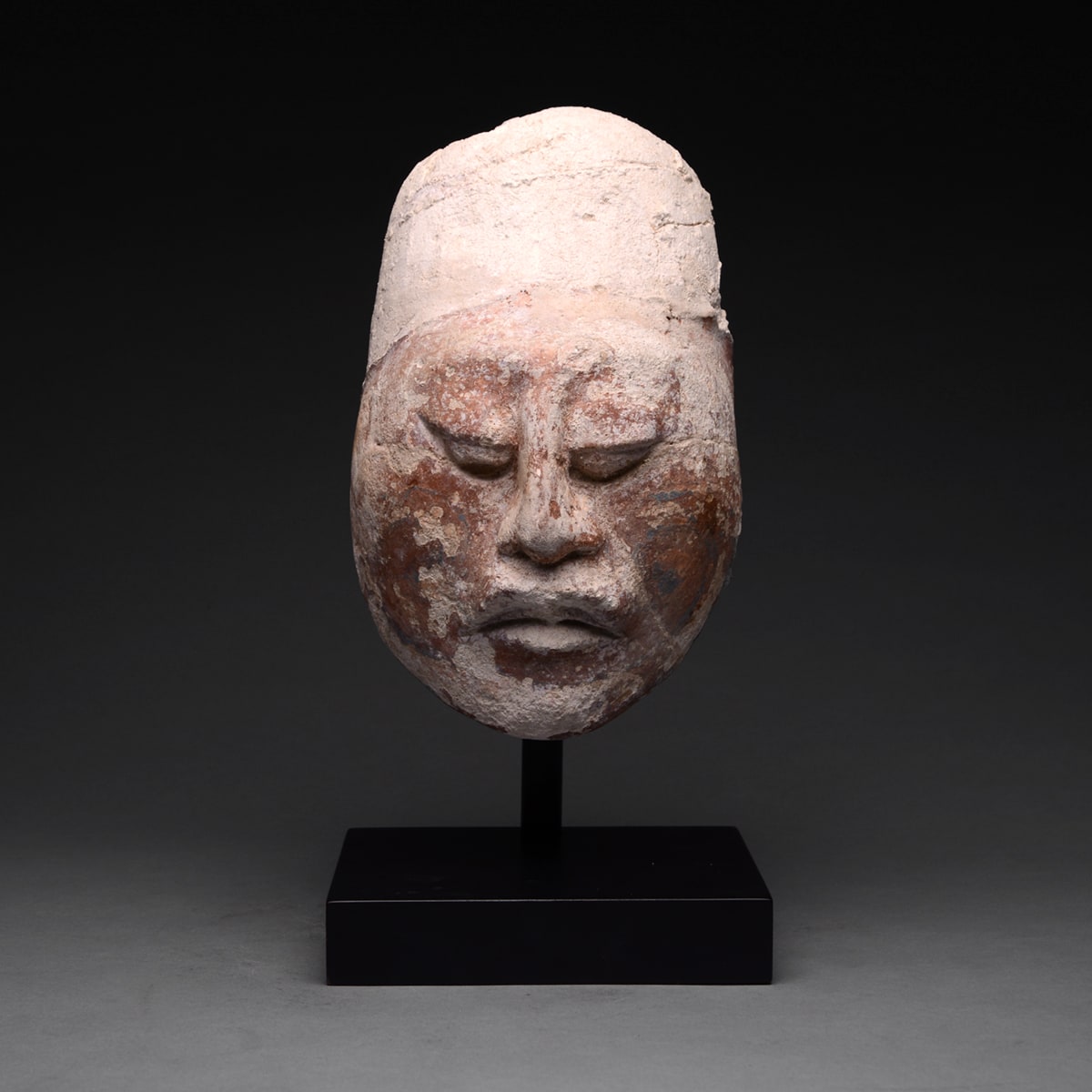Mayan Stucco Head Of A Dignitary, 200 CE - 600 CE
Stucco
height 21.6 cm
height 8 1/2 in
height 8 1/2 in
DJ.1044 (LSO)
Further images
This superb stucco plaster head was made to adorn a wall in some part of the Maya Empire, which sprawled across southern Mexico, Guatemala, Belize, El Salvador, Western Honduras and...
This superb stucco plaster head was made to adorn a wall in some part of the Maya Empire, which sprawled across southern Mexico, Guatemala, Belize, El Salvador, Western Honduras and the Yucatán Peninsula. It depicts a mature male (?) with an impassive, oval face with strong features, notably a prominent nose and chin, and protuberant, heavily lidded eyes. The lips are very full and sensuous, tilted down slightly towards the sides. The top of the forehead is marked with a solid line that is presumably intended to represent the edge of some sort of headwear. The shape of the head, however, indicates that the person portrayed passed through a cranial deformation process as a child, so that the bones of the skull adopted a new shape as they were pressured using a series of bandages and strapping. This process was reserved for socially prominent people; the comparative plainness of this person’s raiment and representation indicates that he was not a king or comparable. He is there most likely to have been a high ranking official or dignitary elder.
Despite being intensely vulnerable to natural disasters, this notoriously changeable area produced one of the foremost civilisations of the New World, with technological and cultural advances that far outstripped their neighbours and contemporary societies much farther afield. The Maya erected the tallest buildings that would be seen in the Americas until the 19th century AD. This timeframe saw a flowering of artistic and scientific endeavour, including the development of a glyph-based literary system that has allowed academics to precisely date historical events, as the Mayans also developed the only reliable calendrical system in the New World.
The stories of creation, beliefs and social information we have for the Maya allows us to reconstruct many of their rituals and practices, combined with archaeological information about economy and the people themselves – for instance, they were much given to the habit of deforming the skulls of their children using strapping and wood boards, in order to produce an elongated shape. They were also enthusiastic about blood-letting, which they used as a gesture of obedience to new rulers, sometimes letting so much blood from their tongues and genitalia (using ropes strung with stingray spines) that entire cities became anaemic. The walls of Maya structures are always decorated in bright colours (often the famous “Maya Blue”), with relief glyphs and stucco designs that included anthropomorphic designs such as this.
This is a mature, reflective and powerfully executed piece from the high point of Maya culture, and a beautiful addition to any serious collection of Pre-Columbian art.
Despite being intensely vulnerable to natural disasters, this notoriously changeable area produced one of the foremost civilisations of the New World, with technological and cultural advances that far outstripped their neighbours and contemporary societies much farther afield. The Maya erected the tallest buildings that would be seen in the Americas until the 19th century AD. This timeframe saw a flowering of artistic and scientific endeavour, including the development of a glyph-based literary system that has allowed academics to precisely date historical events, as the Mayans also developed the only reliable calendrical system in the New World.
The stories of creation, beliefs and social information we have for the Maya allows us to reconstruct many of their rituals and practices, combined with archaeological information about economy and the people themselves – for instance, they were much given to the habit of deforming the skulls of their children using strapping and wood boards, in order to produce an elongated shape. They were also enthusiastic about blood-letting, which they used as a gesture of obedience to new rulers, sometimes letting so much blood from their tongues and genitalia (using ropes strung with stingray spines) that entire cities became anaemic. The walls of Maya structures are always decorated in bright colours (often the famous “Maya Blue”), with relief glyphs and stucco designs that included anthropomorphic designs such as this.
This is a mature, reflective and powerfully executed piece from the high point of Maya culture, and a beautiful addition to any serious collection of Pre-Columbian art.







